
David Meerman Scott is a marketing strategist, entrepreneur, in-person and virtual event speaker, advisor to emerging companies, and author of eleven books including four international bestsellers. He's an expert in helping companies and entire industries move from offline to online. He's presented at in-person events in more than 40 countries and on all seven continents and has delivered hundreds of virtual talks.

Whether you're a seasoned event organizer making the transition to virtual events or just getting your first virtual event off the ground, this guide will equip you with everything you need to run a great virtual event.
|
|
Understanding the art and science of virtual events. |
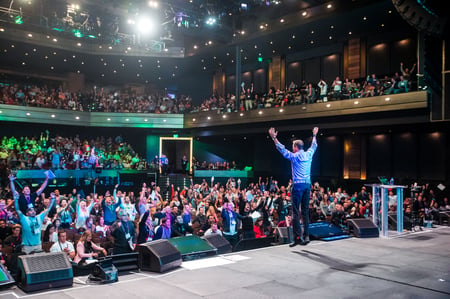 I love speaking at in-person events. The stage and my performance art, meeting new people, reconnecting with friends and colleagues, having one-on-one conversations with people who want to grow their business using the ideas I share in my talks.
I love speaking at in-person events. The stage and my performance art, meeting new people, reconnecting with friends and colleagues, having one-on-one conversations with people who want to grow their business using the ideas I share in my talks.
In the first two months of 2020, I interacted with thousands of people at ten different in-person events I delivered a talk at on three continents.
Then Covid-19 hit. My last in-person event in 2020 was on March 3. I quickly realized that for the foreseeable future, there will be no live events.
Honestly, I started out in a bit of a daze after the shutdown of in-person events in early 2020, spending hours on the online news sites and my social media feeds as I processed what was happening in real time.
Soon I was feeling depressed as I realized I wouldn’t be spending time with interesting people at the live events I love to deliver talks at.
But very quickly I became super excited and hopeful as I’ve been testing many new ways to deliver content to people online. I’m taking the time to learn new things myself and I am eager to share them with you.
I dug into the art and science of virtual events and looked at how to produce effective virtual events from every angle.
I studied what makes virtual events great as well as what the problems are. I focused on what makes for a wonderful virtual presentation. I looked into the technology required and the costs of hosting a virtual event.
I wanted to teach event organizers, companies considering a virtual event, speakers, and others what I’ve learned so that they can produce truly great virtual events.
This guide will take you from understanding the basics of virtual events to teaching you how to choose the right platform, pick the best speakers, what costs are involved, promote your event, and problems you need to avoid. Whether you're a seasoned event organizer making the transition to virtual events or just getting your first virtual event off the ground, this guide will equip you with everything you need to run a great virtual event.
I want to thank the many organizations that have stepped up to create high-quality virtual events at a time when many of us are hungry to learn new things.
I’m firmly convinced that virtual events are here to stay even when in-person events can start up again. Many events will go to a hybrid model with some people gathered in a venue and others gathered online.
I’ve organized the content into chapters and within each chapter there are sections. Feel free to jump around to the content that interests you most.
Virtual events, in the form of an old school webinar, have been around for a well over a decade. However, with the shutdown of in-person events starting in early 2020 many organizations started to re-think what’s possible if people cannot travel.
|
|
Virtual events have tremendous power to create fans of the organizations that host them. |
Virtual events started to generate interest from people who wanted to learn. At the same time, companies wanted to bring people together online to engage in ways similar to an in-person event.
I’m firmly convinced that virtual events have tremendous power to create fans of the organizations that host them. Done well, a virtual event can be the best marketing that your company can do all year. More sales leads can be generated compared to any other campaign. Nonprofits can secure donations. Trade associations can maintain members.
Fandom isn't just for celebrities anymore. It can be rocket fuel for any business or nonprofit that chooses to focus on inspiring and nurturing true fans.
Back in 2015, I began digging deep into the ideas of fandom. I looked at how and why people become a fan of a company, a product, a service, or an idea. It turns out that much of fandom is rooted in neuroscience, which explains the power of both in-person events and virtual events to build fans and grow business.
I wrote about these ideas in my Wall Street Journal bestselling book Fanocracy: Turning Fans into Customers and Customers into Fans.
My co-author (and daughter) Reiko and I spoke with neuroscientists to understand what's going on in our brains when we connect with other people.
Additionally, we looked at our own fandoms to learn why people are so passionate about the things we love. For example, I love live music and have been to over 800 shows since I was 15 years old.
And we spoke with hundreds of people about what they are a fan of as well as companies that have built a massive fan base.
We wanted to know — what's really going on when, for example, I'm with my friends at a live music show? Why do I love live music so much? What is it about being with other like-minded people?
Similarly, why do people spend money and time traveling to in-person events? Can that dynamic be created with virtual events?
We've discovered a prescription for developing fans of any business using a simple but frequently overlooked dynamic in our digital age: virtual proximity.
While in much of the world being close to other people isn’t an option right now due to social distancing, an understanding of the power of proximity is vital to the concept of the virtual proximity we can build with video as part of a virtual event.
Building connections to like-minded people leads to success in business. But can we do the same with virtual events and meetings using tools like Zoom? Yes! And the reason it works is rooted in neuroscience.
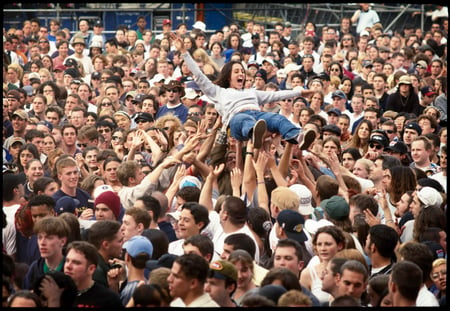
What is it about being around other people that drives connection? Why does physical proximity make such a difference? Cultural anthropologist Edward T. Hall has answers to those questions.
Dr. Hall defined humans' use of space in a simple way. As director of the State Department's Point Four Training Program in the 1950s, Dr. Hall's mission was to teach foreign country-bound technicians and administrators how to communicate effectively across cultural boundaries.
His 1966 book The Hidden Dimension describes how people like to keep certain distances between themselves and other people. Our use of space can affect personal and business relations, cross-cultural interactions, architecture, city planning, and urban renewal.
If we want to be effective in our communication, we need to learn how to consciously manage the physical space between ourselves and others.
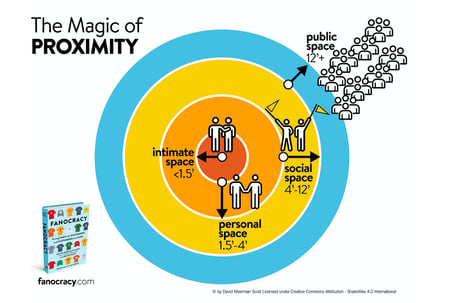 For instance, Hall described "public distance" as more than 12 feet away from others, a distance that lacks any sense of precise interaction among those involved. He identified "social distance" for interactions among acquaintances as being from four feet to 12 feet, and "personal distance" for interactions among good friends or family from about a foot and a half to four feet.
For instance, Hall described "public distance" as more than 12 feet away from others, a distance that lacks any sense of precise interaction among those involved. He identified "social distance" for interactions among acquaintances as being from four feet to 12 feet, and "personal distance" for interactions among good friends or family from about a foot and a half to four feet.
When we’re practicing social distancing as we are now, it simply means that we’re remaining in the public space and social space and not getting into people’s personal or intimate space when we are out of our homes.
Because these basic instincts are so powerful, when we are close to people we don't know, like on a subway platform, we're wary. We can't help that response. It's built into all of us. We're preparing to flee or to fight if presented with any sign of danger.
However, when we are in close proximity to people we trust, when we are with our tribe, a personal connection develops.
People who are able to cultivate physical closeness with customers by engaging with them face-to-face can create stronger emotional bonds.
During normal times when we’re able to interact, the most rewarding encounters in our lives occur in our social space and personal space. It’s why in-person events are so popular.
Those people sitting near one another at a game or at a bar or standing near each other in a line at a live music show? They're well within each other's social space and as such each person can feel the human connection in a positive and safe, unconscious way. It’s why you might feel compelled to give a high five to somebody standing near you who you don’t know when your team scores an important goal. You feel comfortable around others with like-minded interests.
So far, we've looked at the importance of in-person human connection in growing fans.
People go to live music for more than the show — they go to enjoy close proximity with other like-minded people. Humans are hardwired to react to those who are nearby. Our evolution has taught us to unconsciously track those who come near us in order to quickly determine if they are good or harmful.
So how can businesses who can't possibly have a direct personal connection with every fan achieve similar success? Especially in this social distanced reality we’re living in with an audience that could be scattered all over the world.
It turns out that virtual events can still deliver the power of connection.
Through “mirror neurons”, our unconscious brain can respond to what we see as if it is our own experience, even if it is on social media, film, a screen, or a faraway stage.
Mirror neurons are a group of cells in the premotor cortex and inferior parietal cortex of our brain. These neurons are fascinating because they not only activate when we perform an action, they also fire when we observe somebody else performing the same action. Those are a lot of big words from the neuroscientists. What does that actually mean? Well, when others around us are smiling, our unconscious brain tells us we're happy, and we often smile, too. Or, when we see somebody biting into an orange, we might “taste” a bit of that orange ourselves.
A critical aspect of understanding mirror neurons is to remember that it's how we're hardwired. It's our ancient brain at work helping us to cope with the world around us. It's not something we can choose to turn on or choose to ignore. It's innate. We can't help ourselves to react in the way that we do.
People unconsciously bond with what they see on screens and on-stage because of mirror neurons. This helps to explain why we feel that we "know" movie stars and television personalities. Our brain tells us that we've been in their personal space because of the feeling of proximity to them as we are seeing them up on the screen.
The same thing is true for your virtual event! People bond with speakers as if they are in the same room as them and that grows fans of your business.
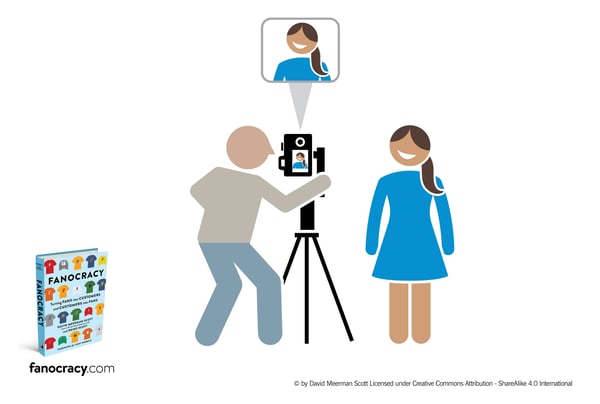
A deeper understanding of mirror neurons can help you build fans within your organization, or market any products and services you want to sell by hosting virtual events.
Businesses can use the concept of mirror neurons to build fans in many ways.
Video of people, as part of a virtual event, is a fabulous way to reach people emotionally through the power of mirror neurons.
When you shoot a video for a virtual event, look directly into the camera and adopt a friendly and open approach.
There are several broad categories of virtual events that you may want to consider.
Webinars have been around for more than a decade. In the old days, a webinar (web-based seminar) was simply a speaker talking over their slides for an hour or so. Later, the ability to have a small thumbnail video of the speaker became available as well as the ability to handle audience Q&A.
These basic webinars are still around, but with greatly upgraded technology. If you are hosting a basic event where you’re not charging a registration fee in the platform, you might consider webinar platforms such as Microsoft Teams, Zoom, or GoToWebinar.
The webinar platforms may also include the ability to live stream your event on social sites like Facebook Live and YouTube.
The webinar-style virtual event is ideal if you want to provide thought leadership content as a way to generate interest in your ideas, products, or services. A webinar is also a great way to host a virtual event to generate sales leads because each person who participates may be a good fit for the product or service your company sells.
Some virtual event organizers host a simple event with one or several speakers in order to charge a fee. While the same webinar platforms such as Microsoft Teams, Zoom, or GoToWebinar can be used, this approach requires additional technology to accept credit card payments.
A simple event where you charge a fee to participate is an ideal way for a company or individual with specialized knowledge to monetize their ideas in new ways.
Many larger organizations host more integrated virtual events, similar to larger in-person events. These may occur over several days, can include dozens or even hundreds of speakers, and might have sponsors. A large event may be free for participants or be a paid event requiring tickets.
For this kind of virtual event, you will need a platform that offers a wide variety of features for participants. These platforms provide an experience for attendees with multiple presentation tracks, roundtable discussions, a virtual tradeshow, breakout rooms, and much more.
The multiple presentation track feature, for example, allows for several simultaneous presentations to happen at one time with attendees choosing the one that is best for them.
Some platforms also have either their own smartphone app or seamless links to a partner app where participants can manage registration, connect with others, and more.
A large event is ideal for organizations who are replacing their in-person client conference or tradeshow for the virtual world. If you are hosting an event for customers and it is free for them to attend, it is possible to save costs that you would have paid with in-person events which means your virtual event may be less expensive overall. If you charge fees to attend your event, a virtual event permits more pricing options than an in-person event.
Why do some virtual events succeed while others miss the mark?
I keep coming back to the idea that people who simply try to recreate the in-person event they are familiar with and comfortable. They don’t tap into the right medium for virtual success.
|
|
The best virtual events reimagine what’s possible rather than recreate what’s familiar. |
Can I geek out a little here? I’ve always been fascinated with how television shows and movies are made and I jump at opportunities to be a part of the business. Long time readers know my book Marketing the Moon was the inspiration for the three-part PBS American Experience mini-series called Chasing the Moon and I served as a consulting producer. I’ll always remember introducing the filmmaker Robert Stone to Apollo 11 astronaut Buzz Aldrin and interviewing him for our film.
I’ve also dabbled in a bit of, well, shall we say “acting”. If you blink you would have missed me in feature films like American Hustle, reality shows like Space Dealers, and television commercials for companies like Toshiba. It’s super fun to see how the magic is made even though I’m usually in the background!
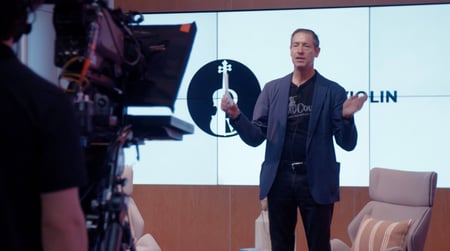 A network television morning program, for example, includes hosts setting the scene and keeping things on track. It includes guests appearing live plus on pre-recorded segments. There are interviews and musical guests, a bit of silliness too!
A network television morning program, for example, includes hosts setting the scene and keeping things on track. It includes guests appearing live plus on pre-recorded segments. There are interviews and musical guests, a bit of silliness too!
However, when speakers play to an audience like they are used to rather than play to the camera, they aren’t as successful in delivering their messages and the entire event can suffer.
I consider an in-person talk to be my art. The big stage. I can’t sing or dance or play an instrument. However, after 500 in-person talks in 40 countries, I’ve enjoyed developing the ability to move an in-person audience to think, to laugh, and to take action. It’s a feeling like no other! It even beats surfing.
Delivering an in-person talk is dramatic and theatrical. It’s a powerful thing to have a few thousand people paying attention to me. I know that going to a particular place on the stage at a certain point in my talk, planting my feet, pausing for a moment, and delivering a well-rehearsed line will bring laughter.
However, those familiar elements aren’t available to speakers when they are delivering a virtual talk.
There’s nowhere to walk to. There’s no stage. And there’s no audience to react.
“This is funny!”, a self-conscious speaker might say into the silence, “You’re supposed to laugh at this!”
As a result, speakers need to think about the art of performing in a different way.
Events need to select speakers that reimagine what’s possible.
Virtual events are more like a live television show than a theatrical experience.
An effective virtual event is much more than televised speeches!
In a virtual event, we must realize that people’s attention spans are much shorter than if there were in a convention center or hotel ballroom. This means we need to keep the interest up by mixing things up, adding elements of surprise, and including the audience as much as possible.
For example, at a recent virtual talk, I shared the story of how YouTube helped my friend Matt grow an Austin based custom home building company from zero to $20 million in ten years. I played one of his videos and talked about the elements of his success. The audience didn’t know that I had Matt secretly lurking. When I finished his story, I said “too bad Matt isn’t here to share with you.”
That was Matt’s cue to pipe up and say hello to the audience. The event organizer was in on the secret, turning on Matt’s video and unmuting him. Everyone was thrilled at this unexpected turn of events. We transitioned to a few minutes of Q&A with audience members asking Matt some questions. It was a highlight of my talk that day.
It’s human nature for us to take what we already know from an offline world and apply it online. Over 30 years working with digital businesses I’ve seen countless people fail as they try to recreate online what they are used to in the offline world.
Newspaper companies missed the online information revolution because they focused on recreating their print newspaper online.
Advertising agencies missed the web marketing revolution by focusing on annoying banner ads.
Our challenge with online events and virtual speaking is to focus on what’s possible, not on what we already know.
The best virtual events are more than televised keynotes! The best virtual events create a powerful online experience.
The key is that we need to use the power of the online medium rather than trying to recreate an offline experience.
For example, great virtual events include ways for the audience to interact with one another during the event. Through tools built into virtual event platforms, attendees can chat with one another, live, as a speaker is presenting. After a talk, virtual meeting rooms can be set up where people who share common goals can collaborate based on the information they just learned.
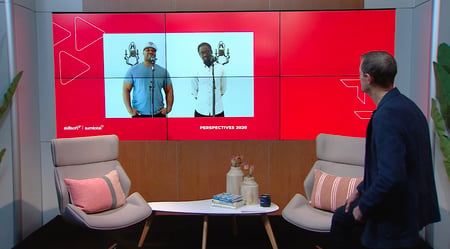 I had an opportunity to deliver the closing keynote and serve as a co-host at Skillsoft Perspectives 2020, an amazing virtual event.
I had an opportunity to deliver the closing keynote and serve as a co-host at Skillsoft Perspectives 2020, an amazing virtual event.
Originally planned as a series of in-person events on multiple continents, the pandemic forced the cancellation. Like many in-person client conferences, Skillsoft moved their Perspectives 2020 online. Rather than just bringing the in-person events online, Skillsoft completely rethought what was possible!
I love that Skillsoft chose a 24-hour “follow the sun” approach and combined the regional events together at one global virtual event. This is a great example of reimagining what’s possible!
Perspectives 2020 kicked off on May 13 at 9:00 am Sydney time and included speakers, panels, case studies, and other programming that originated in Sydney, Singapore, Delhi, London, and Boston, ending at 6:30 pm Boston time with my keynote.
It was super fun for me to be involved over the full 24 hours! I participated in many other ways than just delivering my talk.
Throughout the day, I was at the anchor desk with Michelle Boockoff-Bajdek, Skillsoft’s CMO, serving as the sidekick co-host. Michelle was the leader of the event and I jumped in with “color commentary” at the anchor desk from time-to-time over the 24-hour event. Having hosts was a great way to bring consistency to Skillsoft Perspectives 2020. Participants were grounded in what’s coming next event.
Skillsoft Perspectives 2020 also included a live musical performance by Kev Sylvester and Wil Baptiste of Black Violin who played from their studio in New York City. I was in the Boston studio and interviewed Wil and Kev after their performance. The live interplay between Wil and Kev in their NYC studio was popular with attendees. Black Violin gained many new fans (including me)!
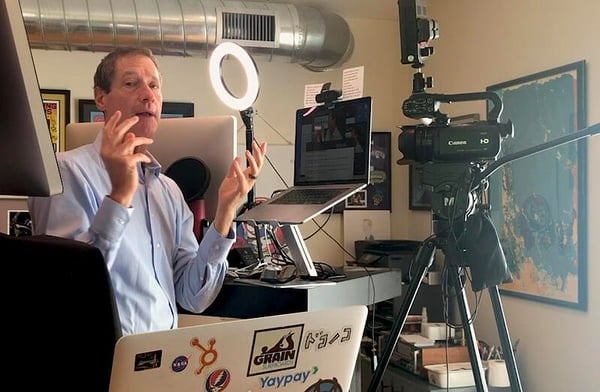
Speakers who are used to presenting from a stage don’t need to set up the technical aspects at the performance venue like sound, lights, and video. Sadly, most speakers I’ve seen carry the same attitude to a virtual event they do from home – they don’t think about technology and setting.
Many speakers simply set up their notebook computers on their dining table. When a camera points up the speaker’s nose and settles on the lights above, it does not help the personal brand of that speaker and makes you as the event organizer look bad.
I recently spoke at a virtual event where a very well known (and highly compensated) speaker presented from his smartphone held in portrait mode. It was dark and foreboding. The sound was terrible. It was like talking to your technology-challenged uncle on Skype. The performance was insulting to the event organizer and to the audience.
If you’re planning an event, it is a good idea to hold a technology check with every speaker and look for ways to improve the look of the video.
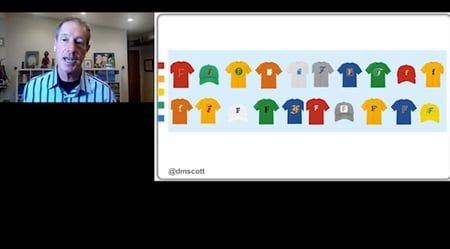 In an effort to provide events with the best experience, I've rethought the norms of presenting virtually. Most people simply present from their desk or dining room table. However, I’ve created a studio in my home to present at virtual events. While my setup may be more than many speakers need, I really like what I can do in my studio.
In an effort to provide events with the best experience, I've rethought the norms of presenting virtually. Most people simply present from their desk or dining room table. However, I’ve created a studio in my home to present at virtual events. While my setup may be more than many speakers need, I really like what I can do in my studio.
Most virtual event platforms are hardcoded to have a presenters’ slides appear large on audience members’ screens with the presenter’s video appearing as a tiny thumbnail.
I don’t feel that is the best way to present my material so I thought deeply about how I can reimagine what’s possible.
I’ve solved this problem by having my slides appear on the video too! This way my talk can be seen in the best way possible.
I use two computers so I can show my slides on a monitor that’s over my shoulder. I’ve found this approach to be much better than the default of so many event platforms.
Rather than using the video camera and microphone built into my computer, I have upgraded to an external camera and mic for more professional video and audio quality.
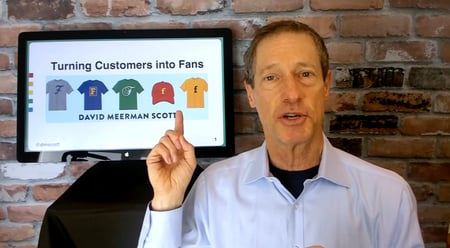
And I have some good quality lights pointed at me so I can pop out of the background.
Yes, I’ve invested in some added technology and the small studio I built takes up some room in my home. We’re all learning as we go and this is just one example of how things could be done. It has been very much worth the effort as I am able to deliver a virtual talk in the best format possible for the audience. People who book speakers should be thinking about how the speakers will appear on the screen, not just the content.
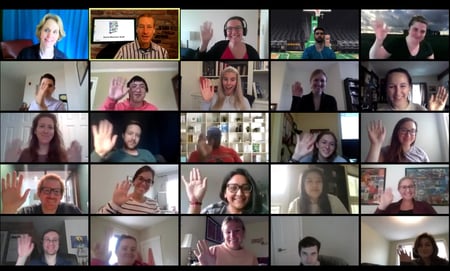 While a great virtual event is more like television than theater, that’s not enough. If you only focus on the TV part, you miss the ability for the audience to interact.
While a great virtual event is more like television than theater, that’s not enough. If you only focus on the TV part, you miss the ability for the audience to interact.
The greatest aspect of an in-person event is an audience being together, interacting, learning from one another, and making professional connections. When people meet at the meals, coffee breaks, receptions, or while waiting for a keynote to start, a powerful tribe of like-minded people can develop.
People come back to an event year after year because an organization has built what I call a Fanocracy around their event.
For example, many of the 25,000 people who attend HubSpot’s INBOUND conference every year are there because of the people they meet who are just like them. Neuroscientists tell us we are hard-wired as humans to want to be part of a tribe of like-minded people.
The challenge for online events is to develop that tribe that is the result of interaction among like-minded people.
Most virtual events fail to provide audience interaction because they simply try to recreate the stage experience in a physical event. They miss out on a big opportunity to use these online to promote interaction between people.
Now that we’ve looked at some differences between in-person and virtual events, let’s turn to some of the benefits of hosting a virtual event.
Business events have been a long-time staple in company calendars since who knows when. A few times a year, employees get to travel to places like Boston, New York, London, and Singapore to hear keynotes from world-renowned speakers, meet other like-minded professionals, and enjoy entertainment.
Even as marketing has become more and more digital, in-person events have remained a mainstay in marketing budgets.
And then COVID-19 happened. Every major event in 2020 appears to have gone virtual. Apple’s WorldWide Developers Conference, HubSpot’s INBOUND, and Saastr are just a few events that will be virtual for the first time in history.
|
|
Virtual events create a powerful tribe of like-minded people. |
What we’re learning is the benefits of virtual events for both attendees and hosts have the potential to permanently change the event marketing landscape.
Virtual events are here to stay even when we get back to in-person events.
Even as in-person events slowly return, the clear advantages of virtual events should have marketers re-thinking how they approach event marketing in 2020 and beyond.
Below, I’ll explore six key advantages to virtual events that drive up attendance, keep the budget under control, and improve marketing strategy for future events.
In chapter 2 I talked about the ideas in my Wall Street Journal bestselling book Fanocracy: Turning Fans into Customers and Customers into Fans. We humans are hard-wired to want to be part of a tribe of like-minded people because that’s where we feel safe and comfortable. When you create a powerful virtual event, there are many possibilities to nurture an existing tribe or start a new one.
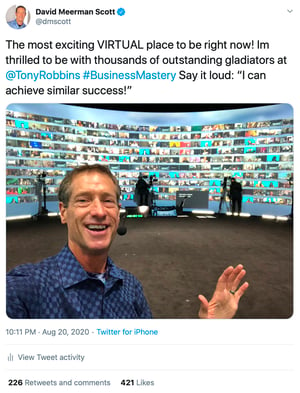 Surprisingly, a virtual event can be more intimate than an in-person event because of mirror neurons, the way our brains react to seeing a video of people that I explained in detail in chapter 2. If a virtual event speaker looks directly at the camera and the image is cropped as if the speaker is about four feet away from the audience, participants feel as if the speaker is talking directly to them.
Surprisingly, a virtual event can be more intimate than an in-person event because of mirror neurons, the way our brains react to seeing a video of people that I explained in detail in chapter 2. If a virtual event speaker looks directly at the camera and the image is cropped as if the speaker is about four feet away from the audience, participants feel as if the speaker is talking directly to them.
I experienced that myself when I spoke at the first virtual edition of Tony Robbins Business Mastery. I’ve delivered a talk several times a year at in-person Business Mastery events.
In August 2020 the event went virtual in a massive purpose-built studio with a 50 foot round screen encircling the stage which displayed several thousand participants on video.
Because I was able to speak directly to the cameras for most of my talk, people felt I was having a conversation with them rather than presenting to a huge group like I was on stage. The resulting photo got tons of social interaction when I shared in Twitter.
Fandom is also created at virtual events when people interact with speakers and with each other on social media and in the event app. It’s people coming together to learn.
The cool part of all of this is that the creation of this tribe of fans is a result of what you do to create the event and that has the potential to benefit your business for years to come.
Saastr, one of the premier business conferences for the tech industry, had 10,000 in-person attendees for their event in 2019. Saastr’s virtual 2020 event drew more than 50,000 attendees for when the event went live in September. This is the power of hosting events online.
Physical events have physical limitations: square footage, seating capacity, and venue availability. Virtual events have no such limitations. As long as attendees can connect to the internet, then they can access an online event. This means your event has the ability to reach people all across the globe.
Events build brand awareness and give customers opportunities to learn, grow, and meet others. All these things can happen with a virtual event but at a much larger scale. If your virtual experience is done right, you can mobilize your online audience into loyal brand fans across the globe. Even after in-person events resume, offering a live streaming option and recording keynotes to share later will help you tap into audiences far larger than any stadium could ever hold.
If you’ve ever attended an out-of-state or out-of-country event, then you’re familiar with hectic travel routines. You have to wake up early to catch a bus, train, or flight. Then there’s the process of checking into the hotel. You have to actually navigate your way to the venue. All of that time associated with just making it to an event can be enough to discourage people from attending at all.
With virtual events, the only hassle for attendees is making sure they have a good internet connection. With everything just a few clicks away, people can access all the benefits of events without having to lose valuable time to travel.
For event planners, the process of booking speakers is more flexible as well. Speakers (like myself) find ourselves booked out for in-person events all across the globe, making it hard to squeeze in last-minute requests or adjust our schedules. However, with virtual events, it’s easy to find time for another booking. For example, I have done several events in one day from my home studio, something that would be impossible if it required travel.
With virtual events, we can deliver our content from a home studio. While speakers need to tailor their keynotes to create a unique experience specifically for the digital space, the added time of travel does not need to be a part of pre-speech preparation anymore. No getting locked out of my hotel room in nothing but a Speedo for my next online event!
According to event software provider Bizzabo, businesses spent nearly a quarter of their marketing budget on events in 2019. Some of the costs for in-person events include booking a venue, securing a roster of speakers, paying event staff, getting signs and physical branding, and creating unique experiences for attendees.
This doesn’t even get into the expenses associated with event management software, event apps, and promotion. Maybe your company had a budget for these things in the past, but there’s no denying the high cost of putting on an in-person event.
With virtual events, physical event costs disappear. Most noticeably, venue booking costs no longer eat up the entire budget. With some major concert venues (where large-scale business events also take place) costing as much as $500,000 per day, event planners can now put this money to use towards other parts of the event or other business initiatives.
On the attendee side, there’s no longer a massive ticket fee. The all-access pass for HubSpot’s INBOUND 2019 stood at $799; the same pass for the digital INBOUND 2020 is currently available $69. What’s more, the general pass for INBOUND 2020 is completely free!
Now, this isn’t to say that virtual events are cost-free. To run a great virtual event, you’ll want to have more than your laptop webcam and a free Zoom account.
Physical events may have the feeling of sitting in an auditorium to hear a speech, wandering through trade booths handing out swag, and meeting up with fellow professionals over a coffee or nice glass of red wine (my choice). While virtual events can’t replicate these things, they can offer unique experiences that change how we think of events.
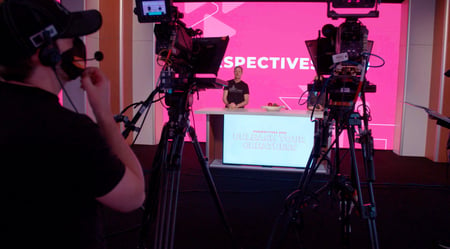 In early 2020, I delivered a keynote and served as co-host at the Skillsoft Perspectives 2020 summit. Originally planned as a series of separate regional events across multiple continents, the event planners repurposed the series into one online event for a global audience. Attendees could tune in based on their time zone, and got treated to top-notch content from amazing speakers for 24 hours. The event even had musicians perform from New York for the audience. What was particularly great was the event app and social media via the #perspectives2020 hashtag were super active during the 24-hour event as participants discussed what was happening.
In early 2020, I delivered a keynote and served as co-host at the Skillsoft Perspectives 2020 summit. Originally planned as a series of separate regional events across multiple continents, the event planners repurposed the series into one online event for a global audience. Attendees could tune in based on their time zone, and got treated to top-notch content from amazing speakers for 24 hours. The event even had musicians perform from New York for the audience. What was particularly great was the event app and social media via the #perspectives2020 hashtag were super active during the 24-hour event as participants discussed what was happening.
Another example are the concerts happening in the video game Fortnite. A massive digital avatar of the rapper Travis Scott gave a performance of hit songs back in May, with the game environment shifting to give players an immersive experience full of special effects and new landscapes to explore. The game’s concert had over 12 million online attendees, making it one of the most-attended events in world history.
Online events that cater to the digital medium give attendees something unique that can only happen virtually. When done right, these events can delight millions of people from all over the globe.
As an event planner, you know how important it is worth their salt will want to gather feedback about their event. They should be asking attendees what worked well, which speakers rocked the crowd, and what could be better for next time.
For an in-person event, attendees might give feedback through an event app or a net promoter score email in their inbox a few days after the event. But measuring these metrics for event success isn’t so easy for an in-person event. Attendees don’t want to be busy with their phones or checking their inbox — they want to be engaged by great speakers, entertainers, and like-minded peers.
With an online event, attendees will be on screens for the entire time. With the right event management software, you can send in-event engagement surveys and collect feedback immediately after an event. You can also very easily see how many people attended certain online sessions and which speakers seemed to get the most engagement from the audience beyond the old crowd volume test.
When every department feels pressure to measure performance, online events give event planners the ability to track metrics while still providing an excellent experience for attendees.
So far, we’ve looked at the difference between an in-person event and a virtual event and the benefits of hosting a virtual event. Now let’s turn to some of the details of putting one on yourself.
Putting on a virtual event requires the wrangling of many different people, technologies, and ideas. Next, you’ll learn some background information on some of the more important components you will need to consider. For a larger event, there will be many things that aren’t included in this list of basic elements.
|
|
Evaluating your options as early as possible means you will have the right elements in place well before your virtual event. |
As you consider what kind of virtual event makes sense for your organization, you will want to evaluate the technology required to connect the speakers with your audience.
If you are hosting a basic event where you’re not charging a registration fee in the platform, you probably want to consider webinar platforms such as Microsoft Teams, Zoom, or GoToWebinar.
Virtual event software from these online meeting companies differs a bit from the base platforms many of us are using every day to meet with colleagues.
You will want to choose a plan that includes virtual meeting features that your company plan likely doesn’t have. Depending on the forms of audience interaction you are looking for, some features you want to consider are controls for the host to mute and unmute panelists, selective recording of the event, Q&A moderation, polling, registration, reporting, and so on.
The webinar platforms may also include the ability to live stream to social sites like Facebook Live and YouTube. This gives the ability to share the event video feed beyond the platform that you select to host it.
For example, I like to use the polling feature (if the virtual event platform has one) about every 10 minutes.
Capitalizing on the features of the virtual event platform changes what would otherwise be a one-way delivery of content to be an interactive experience involving each audience member.
To provide a much more integrated approach to your virtual event, similar to larger in-person events, you’ll likely need a virtual event platform. You’ll also want to consider a virtual event platform if you plan to charge admission to your virtual event.
There are dozens of virtual event platforms. Some that I have presented on include BigMarker, Bizzabo, INXPO, ON24, and Cvent.
Virtual event platforms offer a wide variety of features like experiences as multiple presentation tracks, roundtable discussions, a virtual tradeshow, breakout rooms, and much more.
In certain types of presentations, I also use breakout rooms once every 30 minutes or so to allow 4 to 6 people to discuss for a few minutes what I’ve shared during my talk.
The multiple presentation track feature allows for several simultaneous presentations to happen at one time with attendees choosing the one that is best for them.
Some platforms also have either their own smartphone app or seamless links to a partner app where participants can manage registration, connect with others, and more.
Interestingly, some of the virtual event platforms work seamlessly together with the webinar platforms like Zoom. The best way to think of this is that the presenters use Zoom with the resulting Zoom feed delivered to the virtual event platform where participants view the presentations. Using this approach, the virtual event platform handles attendee user interface, registration, permissions, credit card fees, and so on.
Permit me an editorial aside as you consider a virtual event technology. As a professional keynote speaker and virtual event speaker, I have presented using a dozen or so virtual event platforms. They each have pros and cons which are way beyond the scope of this guide.
As I mentioned in chapter 3, one aspect that I think is super limiting is when the platform is hardcoded so that presenters’ slides are way bigger than the video stream of the presenter like I show above. This is an important consideration because if the slides are at the forefront, it makes it less likely that people will develop an emotional bond to your speakers because the video portion is so small.
Make sure your virtual event audience can see your speakers!
As you are evaluating platforms and speakers, make sure that you have the ability to show the speaker in full screen and the speaker can present without the platform's slide presentation feature. Audiences get bored with big slides and a tiny video and they won’t stick around for the entire presentation as a result.
The way I solve this problem is to have my slides behind me in my home studio.
If you want a fabulous event, you need to make your presenters look fabulous! Unfortunately, the vast majority of presenters at virtual events will simply set up their notebook computer (or worse, their smartphone) on a table and present. The lighting, sound, and much else can really be poor quality.
Don’t overlook the technology required for the presenters. You may need to insist that speakers have, at a minimum, a good webcam, a good microphone, some lighting, and a way to raise the camera so it is at eye level.
I suggest that you insist on a technology check with speakers prior to the event to make sure they are presenting well. After all, that will make you look good too!
All of the webinar and event platforms allow for either a live virtual presentation or the ability to play a pre-recorded presentation. There are pros and cons of each approach, so you will want to consider what’s best for your event.
When you pre-record a virtual presentation, you have the ability to eliminate many of the technical issues that can plague a live session.
Your speakers may be more comfortable presenting in a recorded format because if they make a mistake they can go back and re-record all or part of the talk. While a professional speaker won’t have any issues with live vs. pre-recorded from a delivery standpoint, speakers who don’t have much experience (such as company executives or sponsors of your event) may be nervous and prefer the ability to go back and re-record.
Pre-recording a session also helps to eliminate the possibility of wi-fi randomly cutting out or other issues at a speaker’s location messing up the talk. I’ve delivered several hundred virtual talks from my home studio. I did have one time where the power went out in my neighborhood just prior to my scheduled talk.
I salvaged that talk by delivering it via my mobile phone while the organizer controlled my slides. It wasn’t ideal but it worked. Another time, neighbors chose the moment that I started my talk to remove an enormous tree. While the noise was annoying, I was still able to deliver the talk. Pre-recording my session would have eliminated these issues.
Presenting live is great because a speaker can build interactive elements into the talk. Using features built into the platforms such as chat, polling, and Q&A allow for the audience and the speaker to interact in real-time. If the audience can see one another, you can also use elements like a show of hands so people can see who agrees with them or not.
However, there are drawbacks to the live presentation, mainly because of the technical issues that can arise from poor internet connectivity.
I recommend that whenever possible, you should go with a live presentation. The ability to engage with the audience via chat, polling, and other interactive tools is powerful.
One way to build a totally interactive live experience together with the safety of pre-recording is to record a back version of the talk which is made ready in case of any technical issues. A speaker will record their talk a week or so before the event, which the event producer has ready to play in case of issues. Then, when the live talk is happening, the production team will play the video in parallel to the live talk so if it is needed, they can switch to the recording. I recommend if you use this approach that the producer makes an announcement of what’s happening so the audience understands the nature of the technical problem. Sometimes, it is still possible to do Q&A via the speaker’s mobile phone even with connectivity issues.
I’ve used a hybrid model many times and this might be ideal for your event. In a typical hybrid virtual talk, the main presentation is pre-recorded. Then, at the time the presentation is scheduled to begin, the speaker is standing by while the recording is played.
Interactive components can then be worked around the recording. For example, after the recording is finished, the speaker can take live Q&A.
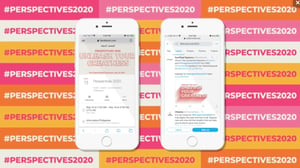
There are a number of ways I use to get the audience involved in my virtual presentation.
When I present online, I like to immediately start out by asking people to share what they are a fan of. It could be a band, a sports team, something they like to do for exercise, a company, a product. Basically anything!
I ask them to type what they are a fan of into the chat feature of whatever platform we’re using. As people’s fandoms scroll quickly by, I read some out loud. And the audience can read them too.
This gets the audience involved from the first minute of my talk!
Social media is also a great way to get people involved. For example, Twitter is an ideal back channel for people to communicate during a virtual event. A back channel is what people are saying about the speakers on the stage while they are speaking and happens in parallel to the programming. Its how people discuss what’s happening on stage. For example, the hashtag #Perspectives2020 was super active during the Skillsoft 24-hour event I was a part of with several thousand social mentions over 24 hours.
Some virtual events have sponsors who pay for an entire event or certain elements of the event.
The simplest virtual event sponsor involves a company hosting a webinar-style virtual event for about an hour with a paid guest speaker. In this case, the company is the sponsor. They host the event, pay for the technology costs, and pay the virtual event speakers’ fees.
Typically, a speaker at this kind of event is a known personality such as a bestselling author whose book is related to the sponsor company’s business.
For example, I write books about fandom, marketing, public relations, and business growth. Companies who provide marketing, PR, and sales software frequently hire me as a guest speaker on their virtual events. I’m the speaker and they are the sponsor.
Many companies host multi-day, multi-track events with dozens or hundreds of speakers. Such events can cost hundreds of thousands or millions of dollars to host when you combine all the technology costs, studio costs, and speakers’ fees.
When one company pays for all of the costs, they are the sponsor. This is typically the case when a company organizes a virtual event for its customers.
With some larger events, typically those hosted by trade organizations or associations, there are multiple sponsors. The event organizer is the association with the sponsors being companies that want to reach the audience at the virtual event.
The organizers who put on these events offer companies the ability to pay a fee to be the sponsor of different elements of the event such as an individual speaker, a content track at the event, or a musical guest.
For example, when my talk is sponsored by a company other than the event host, I frequently work with the event organizer and the sponsor to offer “extras” such as signed copies of one of my books or a VIP question and answer session after my main talk. Everybody loves these “extras” and it encourages companies to step up as a sponsor to support their industry in a positive way.
If you plan to charge people to attend your virtual event, you’re in for a challenge!
With the move to virtual events in early 2020, pricing for attendees has varied widely. I’ve seen some events that used to cost over $1,000 for an in-person ticket become totally free in a virtual setting. And I’ve seen other events where the organizers have tried to keep the same pricing as when the event was in-person.
Hosting a virtual event is an amazing opportunity to have many more people exposed to your organization's ideas. So you might want to consider if it makes sense to offer your virtual event completely free to attendees.
You have the potential to have ten or twenty times the number of attendees or more! I recently delivered a keynote speech at a virtual event that in prior years hosted about 1,000 people when it was held in-person. The free virtual event generated over 50,000 registrations and the average attendee watched more than one talk.
Yes, there are expenses associated with hosting a virtual event and if you make it free. You will have to cover those costs somehow, perhaps with sponsors or as part of your marketing budget.
This free approach is ideal for companies who use their event for marketing purposes and to generate sales leads.
I’ve seen some events that offer certain content at no charge but other content requires a fee to be paid. For example, one event I spoke at recently made all the keynotes like mine free to anybody, but all breakout tracks were only unlocked for paid attendees.
Another interesting approach is to make the real-time talks at your virtual event free but charge people to replay the content at a later date. This approach actually serves to get more people to attend live which is a great outcome.
A hybrid approach can be great for industry events where the content is super valuable and people are willing to pay for it but they want new attendees to be attracted to the free content.
For some organizations, a paid event makes the most sense. For event production companies in the business of putting on paid in-person events go virtual, they will need to charge for the new virtual event too. However, some trade organizations and companies charge a fee for their in-person events and they may want to also charge for the virtual events they are now putting on. Anytime you choose to charge attendees a few to participate, it will be a challenge to figure out what the right price to charge will be!
A paid event is ideal for established events with track records as well as events with super valuable content that people need to do their work.
If you’re hosting a simple webinar, the platform you choose such as Microsoft Teams, Zoom, or GoToWebinar can be used to register people to attend.
However, if you are running a larger paid event with multiple tracks, or an event where people come and go over hours or days, you will need software to process credit card payments and manage people’s credentials to be able to see the content.
So you’ve got your event planned, the technology is in place, speakers are booked, and you’re getting close to the big day. Now you need to get as many people registered as possible!
My suggestion is to get the word out in as many ways as possible.
The first step will be to create a landing page, dedicated webpage, or microsite where all the details of your virtual event are made available. Some event platforms offer integrated pages to host your marketing pages to describe the event. However, you may need to build this yourself and then link it to a registration page.
Adding video to your event page is a great way to generate interest. Ask your keynote speakers to film a short (1 minute) video that you can use. You might also make a short video (2 minutes) like a movie trailer that you can use to promote the virtual event.
Get people to the event page in as many ways as you can!
When the event page is built, link to it from your home page and any other places on your site or blog that makes sense.
Ask your employees to put a very short (one sentence) description of the event into their email signatures and include a link to the landing page.
Social networks including LinkedIn, Twitter, Facebook, and Instagram are excellent ways to get the word out about your event. When you share on social media, use a unique hashtag for your event so you can see social engagement from others. Include links from your social posts to the landing page, microsite, or website where people can register for the virtual event.
Getting the word out about your event on social media can be a great way to generate interest. With your company-branded social feeds, create an editorial calendar with social posts planned leading up to the event. You can share information about each speaker, the topics of each session and more.
You should also tap your partners such as the sponsors of your virtual event (if you have them) and your speakers. Asking speakers to share their participation in your event is an especially valuable way to generate interest.
If you are running a paid virtual event, you can set up an affiliate program with sponsors and speakers and others so that they generate a commission for every event ticket they sell. Typically this is done through coupon codes or unique URLs that can be generated in the event platform.
Event organizers have it rough these days. You’ve got to figure out how to bring your formerly in-person events online. But more than that, you need to rethink what’s possible with a virtual event.
I’ve worked with hundreds of event organizers over the past decade and I hear again and again from you that the toughest part of your job is hiring excellent speakers. Now, with events going virtual, it’s even more difficult because most in-person speakers are not experienced with presenting at virtual events.
|
|
Speakers skilled in virtual events can make your event great! |
Yes, it was and will always be tricky to identify and hire the best speaker for any event.
The reality is that the ways that you choose an in-person speaker may not be effective in choosing the best virtual event speakers.
Speakers skilled in virtual events can make your event great! There are many elements of a virtual event and you work super hard to get the technology right, build an audience eager to participate, and perhaps wrangle sponsors. It doesn’t make sense to invest a bunch of time and money into your virtual event only to have your attendees disappointed because the speakers you chose don’t have much experience presenting on virtual events. Content (your speakers) is very important!
These are the five most common problems in hiring virtual event speakers that can sink your virtual event.
As mentioned earlier, delivering an awesome in-person talk requires drama. In-person events are a theatrical performance. It’s a powerful and rare thing for a speaker to have several thousand people in a room paying attention to their every move and every word.
Skilled in-person speakers understand audience interaction, knowing when a reaction will come and how to make it work in the context of the overall talk. They’re skilled at using a big stage, making certain to visit the outer limits of the stage to mix things up. They know from experience what the result of delivering a well-rehearsed line will deliver.
In a virtual event, people’s attention spans are much shorter than if there were in a convention center or hotel ballroom. This means speakers must mix things up, adding elements of surprise, and including the audience as much as possible.
As you evaluate virtual event speakers, make sure they are skilled at virtual events. Ask to see video of them in action at a recent virtual event, preferably one similar to what you are planning. For example, if you’re organizing a major event with speakers located in a professional studio, ask to see video shot in a studio from the speakers you are considering to speak at your event. If you plan to have the speaker deliver the talk from their home, take a look at a video from an event where they presented from home.
Speakers who frequently present from a stage aren’t accustomed to setting up the technology for their presentation. They simply show up, have a conversation with the production team, and do a technology check to review aspects of the performance venue including staging, sound, lighting, and video camera placement.
None of these details are up to the speaker. You as an event organizer have been planning for months and often it takes several days to set up. Therefore, the speaker simply utilizes what’s available in their performance.
Virtual speaking from speakers’ homes is completely different. Every aspect of the technology is up to the speaker including the background, camera and microphone location, lighting, and much more.
It’s important for you to make sure speakers’ attention to the technical details include more than simply setting up their notebook computer on their dining table.
An important consideration of hiring a virtual event speaker is the technical aspects of how they will present. Make sure you have an opportunity to evaluate a speaker’s use of virtual speaking technology before you make a decision on hiring them.
Audience interaction at in-person events is a major draw for attendees, sometimes even more important than the speakers. When they know they will meet like-minded people, they are more inclined to attend.
The challenge for online events is to develop the community that in-person events naturally create.
Great virtual events have ways for your audience to interact with one another during the event too!
Through the native tools built into virtual event platforms, attendees can chat with one another, live, as a speaker is presenting. After a talk, virtual meeting rooms help people who share common goals can collaborate based on the information they just learned.
The big problem is that most virtual event speakers who simply try to recreate the stage experience in a physical event don’t have experience with virtual audience interaction. They miss ways to use online tools to develop interaction between people in real-time. A lack of interaction during such talks means the one-way nature of the delivery can be boring for the audience watching at home.
In a previous chapter, I shared ways to get the audience involved in a virtual presentation. I’ll mention them again here. The key is to understand the interactive tools offered by your virtual event platform such as chat, polling, Q&A, and breakout rooms, and use them often.
Speakers can use the chat to ask people a question that all audience members can answer right away. For example, I like to start out my talks by asking people to share what they are a fan of. It could be a band, a sports team, something they like to do for exercise, a company, a product. Basically anything!
I ask them to type what they are a fan of into the chat feature and as people’s fandoms scroll quickly by, I read some out loud. And the audience can read them too. This gets the audience involved from the first minute of my talk!
The polling feature (if the virtual event platform has one) is also a good way to get the audience involved. An excellent virtual event speaker will build a polling question into their talk every 15 to 30 minutes so the audience can learn what others are thinking about a topic. Real-time polling is a great example of a way that a virtual event can be much more than a similar in-person event!
In certain types of presentations, breakout rooms can be used to gather 4 to 6 people together to discuss for a few minutes what the speaker has discussed during the talk.
Ask the speaker you are considering hiring for your virtual event if they have ways of building audience interaction into their talks. If a virtual event speaker is skilled at capitalizing on the unique features of the virtual event platform, there is a powerful transformation from a one-way delivery of content into an interactive experience involving each audience member.
There are many aspects of presenting at a virtual event that goes beyond the actual talk. A virtual event speaker needs to be prepared to respond to requests quickly, participate in a technology rehearsal, understand your event, and your audience to customize a talk.
I think of these aspects as the basic requirements. But a true virtual event speaker partnership with an event goes much further.
Some examples might be:
I love that many of the events I present at have active social media backchannels - event #hashtag used on Twitter at conferences or an interactive app or platform are now integral parts of how people interact in real-time. These backchannels move the content from a one-way conversation (speaker on stage to the audience) to an interactive conversation (people in the audience discussing the speaker’s topic which brings in their networks around the world). A virtual event speaker who is a true partner will be active in the social backchannel before and after their talk.
As a speaker, I love to jump into the Twitter backchannel or the event app by checking out the hashtag after I get off the stage. For as long as it takes, I’ll respond to people who have questions on Twitter, which is yet another way for people’s questions to get answered.
Event managers should feel comfortable asking the question about what a speaker will bring to the table. There are many different ways that a speaker can add extra value, and a good virtual event speaker partner will be happy to offer suggestions of how they can help make your event great.
Northern Lights? A beach with waves and the wind in a palm tree? A speaker’s personal logo? At your virtual event? If you want to be taken seriously, I recommend using a real background! Fake virtual backgrounds are cheesy.
The brand attributes of your event are very important!
The virtual background features offered by platforms including Zoom make it seem like speakers are hiding their environment or they think they're cool. Either way, it doesn't work.
It’s better to be real than to be fake
Your audience wants to have a genuine connection with people at virtual events. Encourage speakers to use real backgrounds, even if it is just a wall behind them.
With the explosion of virtual events in 2020, many people have asked me about how much it costs to produce a virtual event. I’m more than willing to answer, but just know that it’s a super broad question!
|
|
Depending on your goals, a virtual event can cost from a few hundred dollars to a million dollars or more. |
It’s possible to host something on a platform like Zoom for a tiny amount of money. It’s also possible to spend millions of dollars too! There are many variables that you need to consider, each with its own costs. But don’t worry, I’m not going to tell you “it depends” and leave you hanging.
To get you thinking about how the costs add up, I’ll provide an overview of some of the elements you will need to consider as you make a budget for your virtual event.
The first element of your virtual event to consider is the online platform you’ll use to host the event. There are dozens of platform providers to choose from with pricing that ranges from a few hundred dollars to tens of thousands of dollars.
Pricing for webinar platforms is typically quoted on a monthly basis per host for an unlimited number of meetings each up to a fixed number of participants. Here are some current pricing options:
I’ve presented on virtual events using Microsoft Teams, Zoom, and GoToMeeting. From a speaker’s perspective, all are excellent options.
So, let’s say you’re planning on running events with one host and up to 1,000 participants each. Zoom charges $140 per month or $1,400 billed annually. Keep in mind that this is a subscription allowing for multiple events throughout the year.
The larger virtual event platforms have wildly varying fees depending on what you need.
As you look into how they price their services, consider the features that you require such as attendee management, registration management and reporting, social promotion, ticketing, credit card processing, chat, polling, breakout rooms, sponsor booths, replays, and so on.
Pricing of these platforms depends on many factors, such as what features you choose and how many participants you will have. Generally speaking, you can expect to pay from $10,000 to $100,000 and up for each meeting, although some platforms charge an annual fee.
Hidden costs: There are likely other costs. For example, if you are charging people to attend your virtual event, don’t forget to account for credit card processing fees which can be 3% to 5% of the amount charged (depending on how you handle the processing.) Some platforms charge additional fees to keep the content up for replay after the live event has concluded so be aware of that. Another cost to consider is the design of the logo, graphics, your web page or microsite, and other branding elements for your event.
If you really want to have a first-class event, you can hire a studio to be your home base for your virtual event.
You can see what a studio setup where I presented in mid-2020 looked like in this highlight video.
Studio costs vary widely depending on what services you require. On the lower end, for half a day with one or two cameras and a basic setup to broadcast your content, you might pay $10,000.
For multiple camera shoots over many hours, more than one set, other technologies like remote studio connections, teleprompter operators, directors, and so on, costs can easily surpass $50,000 per day or more.
You’ll need speakers for your event. While I’m clearly biased because I am a professional virtual event speaker and in-person keynote speaker, I recommend that you spend as much of your budget as you can on the best speakers you possibly can.
Professional speakers skilled in virtual events can make your event shine! You don’t want to invest a bunch of time and money into gathering an audience, getting the technology in place, and then relying on people who haven’t had much experience presenting on virtual events.
Virtual speaking fees vary widely. If you’re familiar with in-person speaking fees, figure most virtual speakers might charge half the cost for virtual vs. in-person.
Yes, you can find people who will speak for free. Often, a no-cost speaker will want to sell something to your audience. Or they are beginners just trying to get some experience. Sure, there might be some that will do a good job. However, in my experience, you get what you pay for with a speaker willing to work for no fee.
A virtual event speaker who has several years of experience and positive endorsements from event planners they have worked in the past might start at a few thousand dollars for an appearance.
Keep in mind that many skilled in-person speakers simply don’t have much experience doing virtual events.
For a well-known speaker such as a celebrity, well known professional athlete, or Wall Street Journal or New York Times bestselling author, fees likely start at around $7,500 and can go up quickly, well past $100,000, depending on how well known the person is.
Again, you must be sure the person you hire is skilled at presenting at virtual events!
I presented at an event with a well-known speaker who charges around $50,000 for an in-person talk. His virtual presentation skills were terrible! He presented on his smartphone in portrait mode with the phone held way down low so it was pointed up his nose and to the lights in the ceiling of his office!
To give a sense of the different levels of pricing when putting it all together, let’s take a look at several different virtual events and their relative costs:
You can spend $1,400 per year for Zoom for an unlimited subscription for up to 1,000 attendees. Pricing would be similar to other Webinar platforms like GoToWebinar or Microsoft Teams.
This allows you to host an event where one person presents at a time. The presenter can appear on a webcam, can show slides, and show videos. Depending on the Webinar platform, you may also be able to have interactive features like chat, polling, and breakout rooms.
If you want to charge people to attend your event, you’ll need to use one of the virtual event platforms like BigMarker, Bizzabo, INXPO, ON24, or Cvent. These platforms typically have an entry price of about $10,000.
Having a fabulous virtual event speaker deliver the keynote at your event might be another $10,000 to hire a Wall Street Journal bestselling author with more than ten years experience delivering virtual keynote presentations.
If you were to have a half dozen professional speakers deliver talks at your event and you filmed them in a beautiful studio setting like that offered at Cramer in Boston with the required virtual event platform, the cost would likely be around $250,000.
Costs can escalate quickly. A large virtual event could easily pass $1 million if it included multiple studios in different parts of the world and a few celebrity presenters.
Wow! There is a lot to consider when running a virtual event! I hope I’ve provided you with some valuable background information as you consider putting your own virtual event together.
|
|
What are the goals for your virtual event? |
Very early on as you are planning your virtual event, you should consider what the goals are for putting the event on. Do you want to make money from the virtual event? Is it primarily to build fans of your organization? Or are you using it to generate leads to sell a product or service?
For some organizations, a paid event makes the most sense. A paid event is ideal for established events with track records as well as events with super valuable content that people need to do their work. It will be a challenge to figure out what the right price to charge will be!
Another way to bring in revenue, typically those hosted by trade organizations or associations, is to have sponsors. You can offer companies the ability to pay a fee to be the sponsor of different elements of the event such as an individual speaker, a content track at the event, or a musical guest.
You should set a goal for how many tickets you expect to sell and how much sponsorship revenue you expect.
Hosting a virtual event is an amazing opportunity to have many more people exposed to your organization's ideas so you might want to consider if it makes sense to make your virtual event completely free to attendees.
If you have a free event, you may be surprised at the number of people who register. It’s important to set a goal and monitor registrations because some platforms charge based on how many people participate.
Some organizations use virtual events to expose new people to their products and services with the hope of generating sales leads. Typically, this approach is used by technology, travel, health and wellness, real estate, financial services companies. The event is free to participate and usually there is a guest speaker who is a draw for people to register.
I recommend that you have three goals if you are using your virtual event to generate sales leads.
There are quite a lot of moving parts to put on a virtual event! I’ve spoken with many virtual event planners who tell me that the two keys to getting everything done to create a checklist of things that need to get done and a timeline for when you need to do them.
You will also want to create an event timeline that uses “day zero” as the start of the event and works backward from there to include all of the things you need to do from your checklist identified by when it will be done.
For example, you might set a deadline for 6 months out from day zero to select the date, 5 months out to select the platform, and 4 months out to select keynote speakers.
You’ll also want to work forward from day zero to plan things such as handling the event replays (if you have them), thanking people who participated, and getting the next year’s event onto the calendar.
And then the whole cycle will start again!
There are a ton of decisions you need to make as you put on a virtual event.
As you consider how to run the best virtual event for your audience, I can help you plan an amazing virtual experience, manage costs, and more. Reach out and connect with me to create a world-class event that will win fans for your business.

I’ve given talks at virtual events in my own home studio and I have access to a wonderful professional studio here in Boston for the setting of an amazing online performance. My keynote on Turning Customers into Fans can also be tailored for your audience.
If you want to turn the potential of virtual events into tangible benefits for your business, please contact me to see if I can help make it the best it can be.
Marketing and sales visionary David Meerman Scott speaks on real-time marketing, agile selling, and helping businesses align with the way people buy.
David is available for keynote presentations, corporate seminars, and webinar appearances.
Fill out the form if you'd like to discuss your event, or visit the Speaking page to learn more about how David can take your event to the next level.
